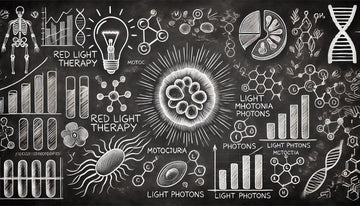Introduction
Red light therapy (RLT) has surged in popularity over the past few years, hailed for its myriad health benefits. As with any emerging treatment, it's crucial to examine the safety profile of red light therapy.
In this post, we will delve into the mechanisms, scientific evidence, potential side effects, and expert opinions to determine whether RLT is a safe option for your health needs.
Understanding Red Light Therapy
More than 7,000 clinical studies and academic research projects have been completed to present the underlying biological mechanisms and benefits of Red Light Therapy. Red light therapy involves exposing the body to low levels of red or near-infrared light. Unlike ultraviolet (UV) light, which can damage the skin and increase the risk of cancer, red and near-infrared light are considered safe and beneficial. Benefits start with stimulating cellular activity in the tissues exposed to the light source and have successive local and systemic effects, including:
- Increased tissue healing and skin rejuvenation
- Enhanced overall skin health and detoxification
- Faster muscle recovery, reduced inflammation, and pain relief
- Bone and cartilage tissue repair and pain relief
- Balanced circadian rhythm and mood improvement
Mechanisms of Action
review published on PubMed Central found that red light therapy is generally well-tolerated and does not produce significant adverse effects. The review analyzed multiple studies and concluded that RLT is a safe and non-invasive treatment option.
Red Light Therapy devices are electrical luminaires. Electrical and fire safety are paramount, as are all other electrical devices in our homes. Piri Red Light Panels do not include components with short service lives, such as frequency inverters and controllers, to extend the service life of the equipment and operational safety.
At-home red light therapy devices are designed with safety in mind. These devices commonly use wavelengths that are proven to be effective and safe even when used unsupervised. The wavelengths that are most studied and proven safe for all common applications range between 630 nm and 880 nm. These wavelengths penetrate the skin effectively without causing damage. Using the correct wavelength ensures that the therapy is both safe and effective. Brand guidelines for usage duration and session frequency are crucial to ensure safety.
Potential Side Effects
While red light therapy is generally considered safe, some individuals may experience minor side effects. Understanding these potential issues can help users take appropriate precautions.
1. Temporary Redness:
2. Eye Safety:
3. Overuse:

Benefits Outweigh Risks
Harvard Health has weighed in on the safety of red light therapy. In an article on Red Light Therapy, they affirm that LED therapy, including red light therapy, is safe for most people when used as directed. The article underscores the importance of consulting with a healthcare provider, especially if you have underlying health conditions or concerns.
When used correctly, the potential benefits of red light therapy far outweigh the minor risks. It is widely used for various health and wellness purposes:
- Skin Health: RLT can improve skin texture, reduce wrinkles, and treat conditions like acne and psoriasis. The increased collagen production helps in reducing fine lines and improving skin elasticity.
- Muscle Recovery: Enhancing muscle recovery post-exercise is another significant benefit. The therapy promotes faster healing of muscle tissues, reducing soreness and fatigue.
- Pain Management: Red light therapy is effective in alleviating chronic pain and reducing inflammation. It is commonly used by athletes and individuals with joint pain or arthritis.
- Mental Health: Emerging research suggests that red light therapy can improve mood and reduce symptoms of depression. This is attributed to its ability to stimulate cellular activity and enhance overall brain function.
Conclusion
Red light therapy is a promising and safe treatment option for various health issues. Its safety profile is well-supported by scientific research and expert opinions. Its non-invasive nature, minimal side effects, and extensive benefits make it an attractive choice for those seeking alternative treatments. It is crucial to follow the recommended guidelines, and a healthcare professional should be consulted for pre-existing conditions or personal concerns. As always, personal research and professional advice are key to making informed health decisions. With the right approach, red light therapy can be a safe and effective addition to your wellness routine, and you can safely enjoy the numerous benefits that red light therapy has to offer.




